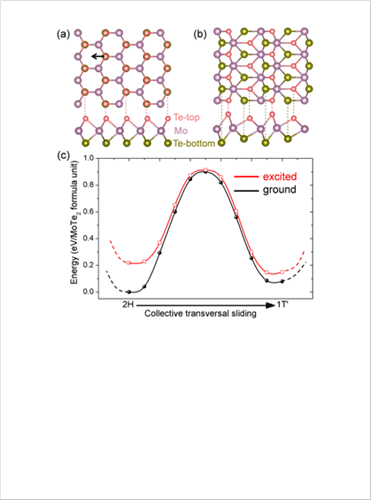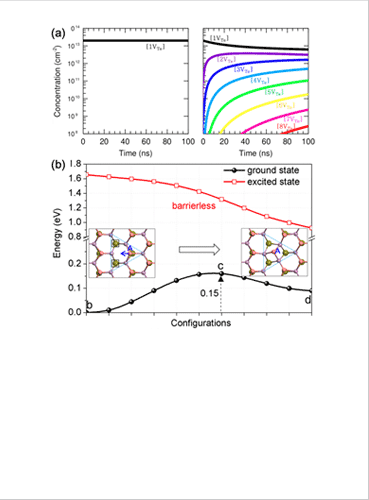Representative Research Publications
Photoinduced Vacancy Ordering and Phase Transition in MoTe₂ 2019 > Representative Research Publications > Research Results Home
Photoinduced Vacancy Ordering and Phase Transition in MoTe₂
- Nano Lett. / May 2019
- Junhyeok Bang (Corresponding author)
Study Summary
We show that non-equilibrium dynamics plays a central role in the photoinduced 2H-to-1T′ phase transition of MoTe₂. The phase transition is initiated by a local ordering of Te vacancies, followed by a 1T′ structural change in the original 2H lattice. The local 1T′ region serves as a seed to gather more vacancies into ordering and subsequently induces a further growth of the 1T′ phase. Remarkably, this process is controlled by photogenerated excited carriers as they enhance vacancy diffusion, increase the speed of vacancy ordering, and are hence vital to the 1T′ phase transition. This mechanism can be contrasted to the current model requiring a collective sliding of a whole Te atomic layer, which is thermodynamically highly unlikely. By uncovering the key roles of photoexcitations, our results may have important implications for finely controlling phase transitions in transition metal dichalcogenides.
 Figure 1. Top and side views of atomic structures of (a) 2H and (b) 1T′ MoTe₂. Arrow indicates the horizontal displacement of a top-layer Te atom to the hollow site. Purple, pink, and olive balls are Mo, top-layer, and bottom-layer Te, respectively.
(c) Total energy in the 2H-to-1T′ transition by a collective transversal sliding of top-layer Te atoms. Black and red lines are for the ground state and excited state (with a 0.93% excitation), respectively.
Figure 1. Top and side views of atomic structures of (a) 2H and (b) 1T′ MoTe₂. Arrow indicates the horizontal displacement of a top-layer Te atom to the hollow site. Purple, pink, and olive balls are Mo, top-layer, and bottom-layer Te, respectively.
(c) Total energy in the 2H-to-1T′ transition by a collective transversal sliding of top-layer Te atoms. Black and red lines are for the ground state and excited state (with a 0.93% excitation), respectively.  Figure 2. (a) Time evolution of ordered vacancy concentrations in (left) ground state and (right) electronic excited state with the initial condition.
(b) Total energy profile in a local 1T′ phase transition (black line for ground state and red line for electronic excited state). Insets are atomic structures at the initial position
Figure 2. (a) Time evolution of ordered vacancy concentrations in (left) ground state and (right) electronic excited state with the initial condition.
(b) Total energy profile in a local 1T′ phase transition (black line for ground state and red line for electronic excited state). Insets are atomic structures at the initial position
Expected Effects
We have investigated the dynamics of the laserinduced 2H-to-1T′ structural transition in MoTe₂. Whereas the 2H-to-1T′ phase transition has been viewed as a collective sliding of an entire Te atomic layer, the actual transition cannot be so simple (due to its exceptionally large energy barrier) but involves a set of successive nontrivial excited-state dynamics: photoinduced Te vacancy diffusion and ordering to generate the nucleus and facilitate its growth of the 1T′ phase. Our findings suggest that the control of the vacancies and simultaneously the excited carriers holds the key to the robust phase engineering of TMDs for promising electronic and energy applications and should be experimentally tested.



